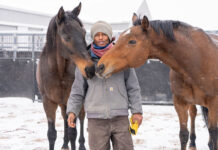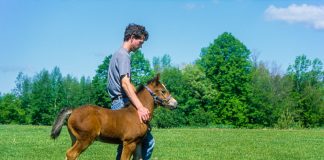When a horse has behavior problems, it’s easy to turn to quick fixes. Instead, discovering the root causes of the unwanted behaviors is the most effective path to solutions that are more beneficial in the long run.

The Speedy Horse
Your goal is to remain in control of your horse’s speed by keeping his hindquarters engaged and his shoulders mobile. Work on circles and steering your horse through sharp changes of direction. Outfit him in a snaffle or a soft curb bit with short, hinged shanks, and ride with two hands on the reins.
Begin by guiding your horse onto a medium-sized circle at a jog. Shorten your inside rein using enough steady pressure to put a bend in your horse’s neck and flex his head to the inside of the circle. When he’s doing this correctly, you will have a clear view of his eye. At the same time, maintain a light feel with your outside rein to provide even support to both sides of his body. Apply inside calf pressure an inch behind the cinch to push your horse’s ribcage out and create a bend in his body that reflects the arc of the circle. With his body in this posture, it will be more difficult for him to brace against the bit. This curved frame also engages his hind end by bringing his back legs forward under his belly, making it easier to maintain a consistent and easy-to-control speed. Wait until your horse is comfortable at the jog before trying this exercise at the lope.
Next, add tight changes of direction. As you’re walking or jogging down a straight line, use a leading rein to direct your horse into a sharp half- or three-quarter turn anytime you feel him accelerate. Lift the rein until you feel a connection with your horse’s mouth, and then smoothly push it away from your body and into the direction of the turn. Help your horse by shifting your weight back in the saddle and urging him forward with both legs. When his hind end is working properly to propel him through the turn, you will feel him get lighter on the reins and step through the turn more effortlessly.
The Slow Poke
The exercises above will also work to speed up the sluggish horse, unless he is unresponsive to your leg. If that’s the case, then use the ask-tell-demand cueing sequence to increase his sensitivity. First try asking him by using steady calf pressure and encouraging him forward with verbal cues like kissing or clucking. If that’s not working, tell him by bouncing your leg firmly against his side, bending your knee and slapping him with the instep of your foot, or rhythmically nudging his ribcage with your heel. If neither of those work, demand with an authoritative, but never harsh, slap of the reins behind your leg or across his hip. This should only be used as a last resort. By consistently employing these three steps, your horse will learn to respond to the more subtle “ask” cue and need “tell” and “demand” less frequently.
The Drifter
Imagine you’re pushing a wheelbarrow. You steer it in the direction you want to go by lowering one of the handles—the lean causes the turn. Likewise, when a horse drops his inside shoulder, he’s leaning in order to turn. This can also cause the tendency to drift off the rail. Combating your horse’s tendency to drift is a matter of gaining control of his front end and removing the lean.
Start by riding your horse on a medium-sized square at the jog. As you approach a corner, take enough feel of your outside rein to tip your horse’s head away from the turn. Hold your inside rein away from his neck to create an open space into which his shoulders can move. Then take your inside leg off his side while you slide your outside leg forward to the cinch and cue him to step shoulders-first around the corner. Once your horse learns to move his shoulders away from your leg pressure, use those same cues, but with the inside rein and leg, to prevent or correct him from drifting off the rail.
Head in the Clouds
If high-headedness is your horse’s problem, culprits to consider include an ill-fitting saddle, dental issues, an unsuitable bit and rider error.
Proper saddle fit and a good pad will allow healthy muscle function and encourage your horse to flex his spine. If your saddle isn’t sitting like it should, it won’t distribute your weight evenly. This can create painful areas of pressure on your horse’s muscles, spine or withers. Even a tolerant or well-trained horse will lift his head to find relief.
A saddle should fit without pinching your horse in any way; it should clear his withers and not come into contact with his spine. Signs of pressure points, which indicate decreased circulation, are dry or rubbed patches in his coat that you’ll see when you remove your tack after a ride. Situate the leading edge of the saddle tree behind the curve of your horse’s shoulder blades to keep his back comfortable.
Back pain isn’t the only reason your horse may not want to maintain proper head carriage. Have him seen by a vet or an equine dentist to check for sharp points and hooks on his teeth.
An unsuitable bit can also prevent your horse from relaxing and lowering his head, or you could be unwittingly rough with your hands. That’s why it’s important to assess how you communicate with your horse. Be aware of any tension in your body, hands or arms that could flow from you to him. Breathe deeply and steadily. Rest the reins softly in your hands and keep your arms relaxed at your sides. Ride with your hands in front of the saddle and your elbows slightly ahead of your hips to lessen the chance of making your horse feel confined. When you make contact with his mouth, do it smoothly so he isn’t startled. Establish light pressure and then wait for a count of two to give your horse time to respond, increasing gradually if necessary.
If your horse retains his high-headed behavior once you’ve eliminated these causes, he’ll need to be taught that rein pressure is a cue to lower his head and relax his topline instead of stiffen up. At a standstill with both hands on the reins, choke up on one rein until you have a firm feel of your horse’s mouth. Then wait for him to bend his neck, but don’t release the pressure until he lowers his head as well. Be patient, and put slack in the reins as soon as he responds. Reinforce this new habit at the walk on a circle, bending your horse to the inside of the arc. Then do the same at the jog. Put slack in the reins to reward your horse whenever his head goes down.
Mind the Gap
Perhaps your horse’s tendency is to open his mouth against the bit. A noseband will keep his mouth closed, but only by addressing the symptom. The underlying issue is often discomfort. Start by choosing a bit with a curved mouthpiece that follows the shape of your horse’s lower jaw. It shouldn’t pinch or have any rough edges. If it’s a curb bit, make sure it doesn’t trap your horse’s lips between the shanks and the curb strap when the bit is engaged. Check it by gently pulling on the reins while standing next to your horse in order to draw back on the shanks.
Effective communication can also prevent your horse from rooting against the reins. However, if it’s a behavior your horse has already picked up, correct it by bracing one or both reins against the saddle horn or swell while tightening your core muscles. This will keep your horse from pulling you off balance or taking the reins out of your hands. Don’t release the pressure until he stops pulling. Avoid a tug of war, which you can’t win. Letting him pull against himself (the rein set against the saddle) will remove his incentive to continue the behavior.
Whether you have years of experience or are completely new to horses, you alone influence your horse’s behavior under saddle. Horses need consistency, confidence and clear communication to do well. Every ride is important. If there are improvements you’d like to make in your horse’s behavior and performance, work on them every time you’re in the saddle so they become second nature to both of you. Leave your expectations at the door and get the best ride your horse can give you on that day.
Further Reading
Handling Bad Behavior
Trail Problem Solver
This article originally appeared in the November 2013 issue of Horse Illustrated. Click here to subscribe.







Great article! First Comment!!!
Good to know
I will have to reread this articles, because it has a lot of great information.
great information
a lot of great information here! thanks!
Great advice.
I am going to find out more about one of my horse’s issues. Good Reading!!
Good info!
Good article
cool
My young horse always manages to get his tongue over the bit.
Nice Article
cool
Very helpful!
Good to know.
Great article. However on the ‘head in the clouds’ part, Ithink it should address the different breeds. Some breeds have a naturally high head carriage. Example being the American Saddlebred, Tennesse Walker and a few other trotting show breeds. It is desirable in those, whereas in Quarter horses and such the low head carraige is what they want.